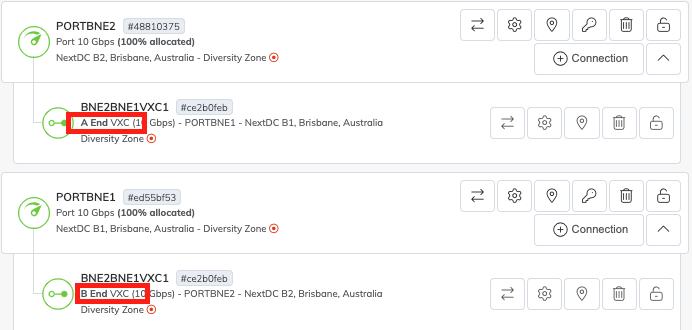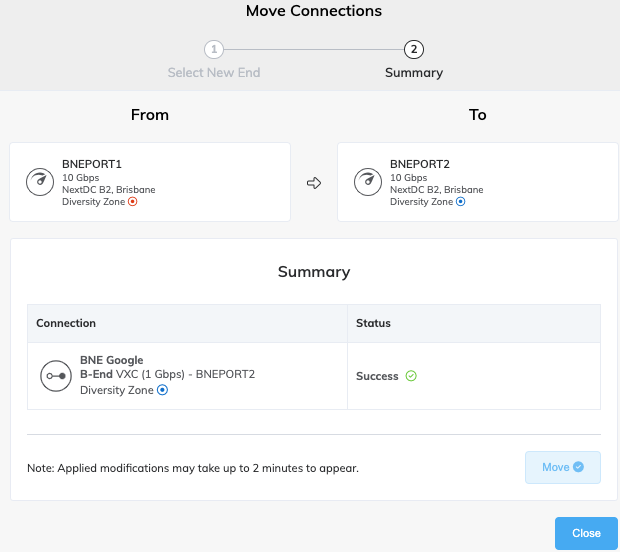Moving VXCs
Once you have created and deployed VXCs on the Megaport network, you can move one or both ends, subject to some rules. You can move VXCs on Ports, MCRs, and MVEs. This is a useful function for reducing interruptions during maintenance and other tasks that would otherwise cause downtime.
Which VXCs can be moved?
The following rules apply regarding which VXCs you can move:
- Any user who can change the speed of a VXC is allowed to move the VXC from any account type.
- You can move any VXC type as long as it is not locked or pending approval.
- You can move an unlocked VXC under a locked Port.
- No approval is required for Megaport Marketplace or Service Key VXCs.
- The source and destination Ports must be owned by the same customer account.
Conditions for moving a VXC
There are conditions that must be met before moving a VXC. The following criteria must be satisfied before you can move a VXC.
- The move can only be to a service of the same type. For example, Port to Port, MCR to MCR, or MVE to MVE.
- You can only move to a Port in the same metro as the current Port. For more information about metros, see Metro IDs.
- The destination Ports must have enough capacity for the selected connection.
- When a VLAN is specified, that VLAN must be available on the destination Port.
- The move must not cause a change to billing.
If a move is regarded as invalid, the connection will be greyed out and cannot be moved.
If you cancel a move, the VXC is not affected and it remains connected to its original Port.
Moving VXCs on MVEs
Moving a VXC on an MVE supports MVEs with multiple vNICs. When moving VXCs for MVEs with multiple vNICs, you can:
- move a VXC to a different vNIC on the same MVE.
- select the required vNIC on the destination MVE when moving a VXC between different MVEs.
Moving one or more VXCs
You can move one or more VXCs at a time. Select the service that the VXCs are to be moved from, then select the VXCs to be moved.
This example shows how to move a VXC on a Port.
To move one or more VXCs
-
In the Megaport Portal, go to the Services page and select the Port you want to use.
Tip
The A-End and B-End of the VXC are shown as connections on the relevant Port. Make sure you are moving the correct end.

-
Click the Move Connections icon on the Port or on the VXC.
Tip
The Move Connections icon is greyed out if the Port or VXC is not valid. For more information, see rules and conditions above.

-
Click to select one or more connections to move. Each move is subject to the rules and conditions described above. If a connection is not valid, it will be displayed but will not be available to select.
Tip
You can select or deselect connections individually, or use the Select All button.

-
Select the destination Port in the Move To area.
The Port selection list is filtered by the rules described in the rules and conditions described above. If a connection is not valid, it will be displayed but will not be available to select.
Tip
You can filter the Ports by selecting a diversity zone at the top of the Move To list.
-
Click Next.
-
Review your selection and click Move.

-
On the prompt that shows the intended move, review the details again and click Confirm.

The Summary table shows the status of the move. It will either show a working hourglass, a message saying success, or an error message.
The Success status means that the request was successfully submitted and the VXC(s) have been moved.
A Failure message shows that the move has failed. The connections will not be moved.
